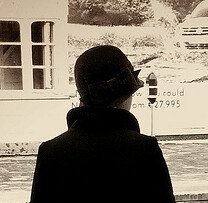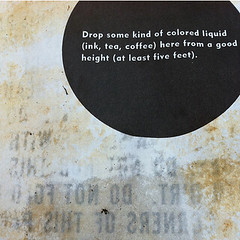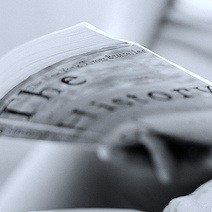1 Art
So, stop me if you’ve heard this one. A book was walking across the counter (after lighting a pipe) and broke its binding when it slipped on a banana peel. Oh, it’s a new one? Then slide on over to enjoy this collection by Jonathan Wolstenholme, who created a series of watercolor paintings capturing books in all sorts of interesting positions. I love the book that’s writing. (Hi-Fructose)
When you’re done reading those books (which I expect will be complicated with those arms getting ahead of you and turning the pages) you’ll want to return them to the library. Perhaps you could choose one of these — beautiful libraries from television and film. Just watch out for the banana. (Flavorwire)
2 News
We think, somehow, that social networks are a phenomenon of the Internet age, but really, the Internet merely facilitates and expands networks that have always existed. While Facebook didn’t suggest mutual friends or people-he-might-know to William Shakespeare, he influenced and was influenced by others of his day. A research project underway at Carnegie Mellon University called Six Degrees of Francis Bacon seeks to identify and “trace the influence and ideas of Bacon, Shakespeare, Isaac Newton and more than 6, 000 others from the early modern period—16th-17th centuries.” A massive, fascinating undertaking. (Carnegie Mellon University, Six Degrees of Francis Bacon)
3 Publishing
The problem with modern publishing? Large publishers are eating up small publishers and publishing more books than we can read in year. Or maybe it’s that readers want to read bad books instead of good ones. At least that’s how Michael Krüger, publisher at Carl Hanser Verlag in Munich, sees it. Take a look at this thoughtful, and at times biting, interview with successful German indie publisher Krüger on the state of the industry. (Publishing Perspectives)
I have no explanation for the fact that modern societies have invested tons of money into schools and universities only to find out that horrible books are much more loved than the good ones…
4 Business
By now we all agree there’s poetry in the workplace. Right? I thought so. Even though we think poetry already exists where you work (you just have to watch and listen for it), we also think bringing poetry to work is a great idea. In fact, this month we’re encouraging you to bring a poet to work. We’re celebrating the first ever Take Your Poet to Work Day on July 17. To help you celebrate, we’ve been releasing poet profiles and cut-outs that you can take along with you. (Take your pick: Sara Teasdale, Pablo Neruda, Haiku Masters, and T.S. Eliot for starters.) Get yours, and take a picture or video of your poet at work with you. We’ll have more information soon about how to share your images and maybe get featured.
It’s fitting that Emily Dickinson just made the Take Your Poet to Work list. In an essay for the Library of Congress, Jennifer Harbster asserts Dickinson was part scientist, even postulating that her poem “632” is a model scientific inquiry. “Each quatrain begins with a line of hypothesis, followed by a line of experiment and two lines to analyze the results. The poem is a triumph of the scientific method.” I fully expect, then, to see the scientists among us propping Dickinson up in a beaker. But try to keep her away from the Bunsen burner, please. (Library of Congress)
5 Creativity
Last time up, we talked about the study that said that coffee was so good at making your brain focus that it robbed you of potential creativity. (Meaning: it’s good to let your mind wander.) Now another study (just pick one — there are enough to read every day for the next year and get a different conclusion) suggests that caffeine interacts with brain chemicals in such a way as to help with memory formation and holding dementia at bay. Makes one wonder if Emily Dickinson drank coffee, and if she did, whether she might have an unnumbered poem somewhere laying out her hypothesis, experiment, and analysis. (New York Times Health)
Here, by the way, is a little something that can happen when one takes coffee and creativity to its logical (and typographical) end. (Behance)
Be careful, though, that the caffeine doesn’t keep you awake at night. Perhaps you experience some of these common sleep problems. If you do, you may not be able to tap your creativity. The answer? It could be something as simple as a bedtime ritual. (Fast Company)
6 Write-It
Ever listen to yourself while you’re writing? We were telling stories orally long before we had a written language for them. With that in mind, Amber Kelly-Anderson suggests that reading your work out loud–keeping stories in their native form–can encourage a writer to play with words, find characters’ voices, and keep the right pace. (Ploughshares)
7 Poems
Sometimes when I hear a poem read aloud, I catch sounds and meanings I wouldn’t have if I simply read silently on the page. In a similar way, seeing a poem on video sometimes reveals images I wouldn’t have seen in the words alone. Perhaps you’ll hear, or see, something in this video poem, “The Dream, ” by Tishani Doshi. (Motionpoems)
In his poem No More Same Old Silly Love Songs, Neil Carpathios writes of his heightened awareness when he no longer had the radio to listen to on his drives. He uses simple words in the poem, conveying clear images with “no wordy embellishment.”
No More Same Old Silly Love Songs
trees.
I began to stop exaggerating the color of leaves,
how their reds and oranges needed no wordy
embellishment.
Read the rest of No More Same Old Silly Love Songs at Every Day Poems
8 People
Fans of Wendell Berry will appreciate this story by his daughter, Mary Berry. She tells of the family’s move back to Henry County, Kentucky, and her reaction to publicity surrounding their way of life—notably the family’s compost privy and lack of modern amenities such as television and junk food. She poignantly describes a drift from her father which was mended when, as a college freshman, she read Berry’s The Memory of Old Jack for the first time. (Edible Louisville)
Trouble has come to me in my life as it does to all and I have made mistakes. The gift that my father gave me so many years ago was the knowledge that I live in his love, and if forgiveness is needed it has already been given. What greater gift could a parent give a child? Daddy has kept alive in my head — even in the worst of times and in the face of awful news — that if we actively choose it over and over everyday, we can indeed live in the world of affection and membership that he honors in his life and his stories.
For bonus Berry points, check out this second article by Mary Berry, about her mother and Wendell Berry’s wife Tanya.
9 Books
Next time you pick up a good old novel to read, pop open Placing Literature on your web browser and map the novel’s geographic locations. You could even use it if you were traveling to a city where your favorite novel took place, and hit all the main character’s hotspots. (AppNewser, Placing Literature.)
Not sure what novel you’d like to place? Pick up this tiny USB device and you’ll have 3, 000 classic books to choose from.
10 Sound n Motion
You’re familiar with data visualization–using images to illustrate data on a particular topic. University of Minnesota student Daniel Crawford has gone a step farther: data sonification. He’s set data to music in this haunting illustration of climate change. (Open Culture)
Photo by Dicktay2000. Creative Commons via Flickr. Article photos by Claire Burge. Used with permission. Post by Will Willingham.
- Earth Song Poem Featured on The Slowdown!—Birds in Home Depot - February 7, 2023
- The Rapping in the Attic—Happy Holidays Fun Video! - December 21, 2022
- Video: Earth Song: A Nature Poems Experience—Enchanting! - December 6, 2022










L. L. Barkat says
oooo, that climate change soundtrack. Yeah.
Your banana peels make me laugh. Why are bananas so good for that? Works every time 🙂
Donna says
That was so sensory… the climate change soundtrack. I would love to know what the sound track might have sounded like back when the Finger Lakes were formed by melting glaciers. That would be really neat to compare the two, too! I wonder if there is a way to estimate and recreate it?
Great post!